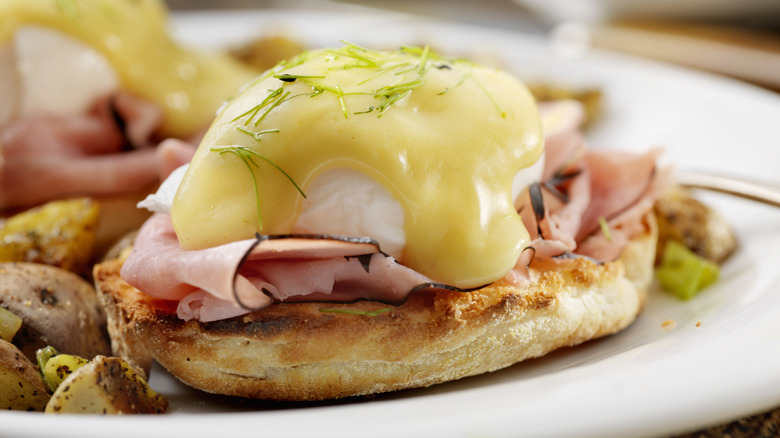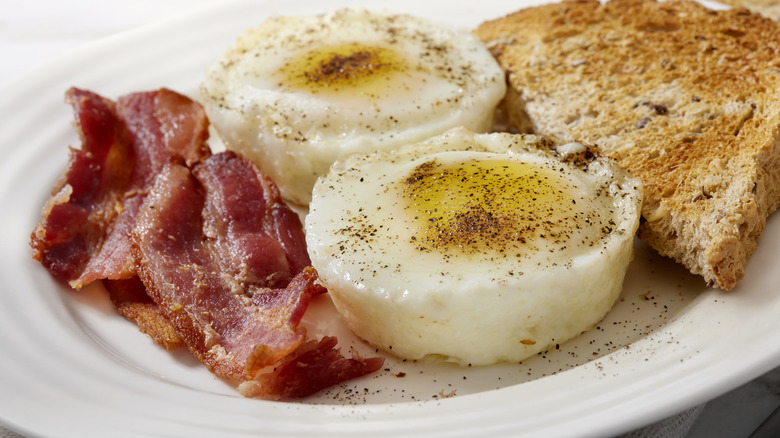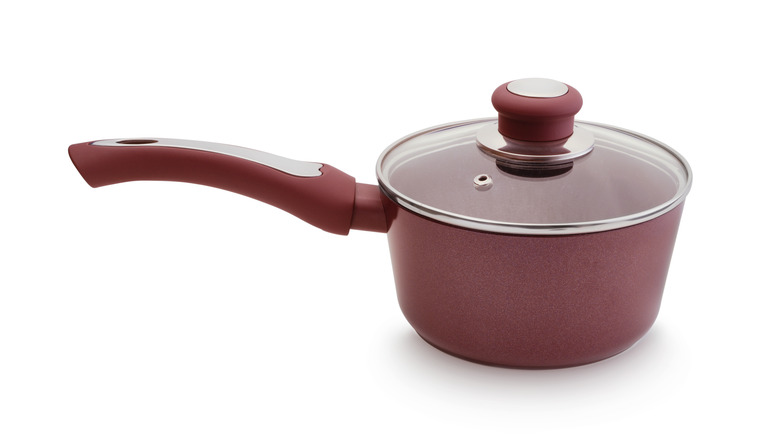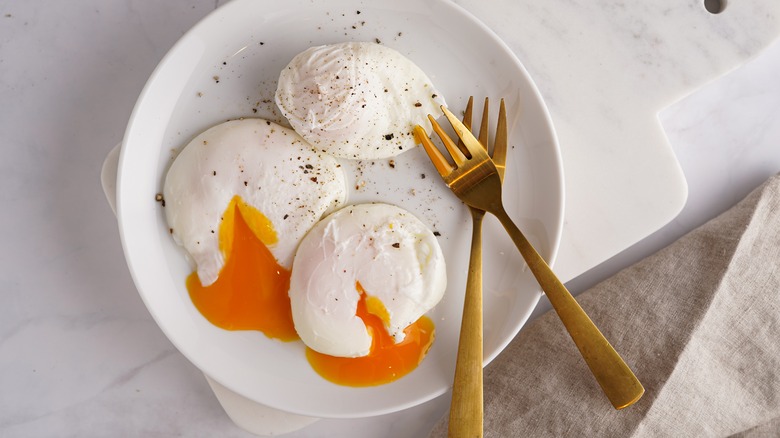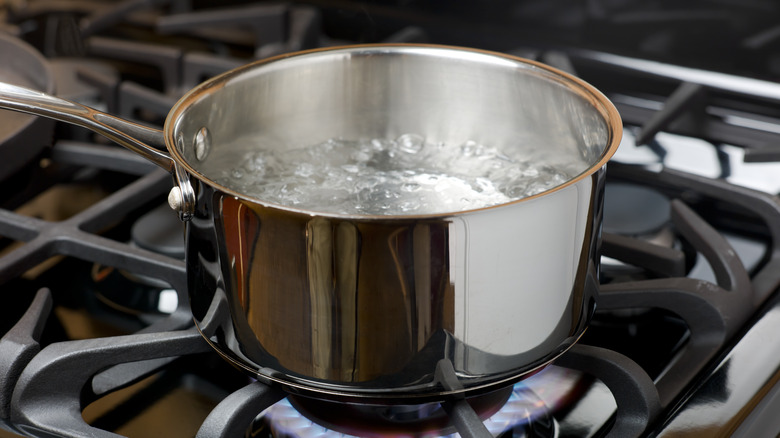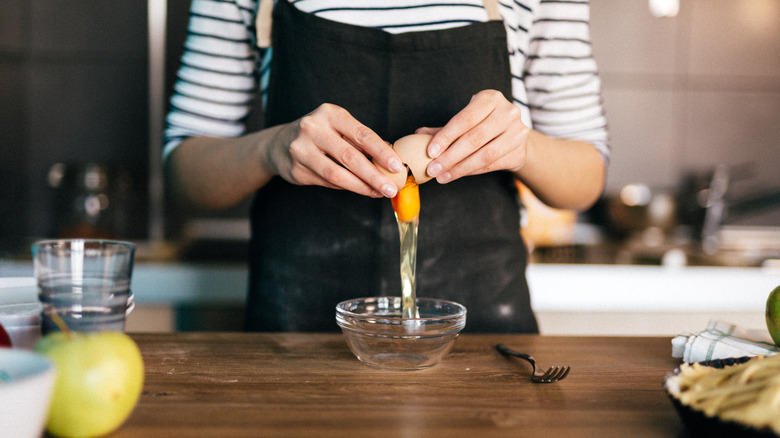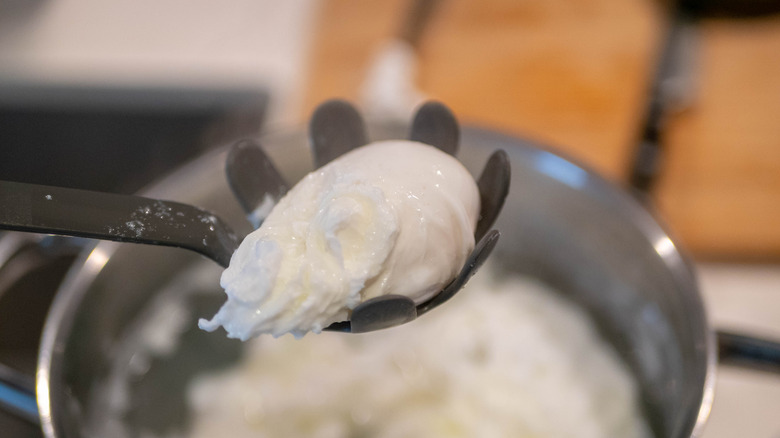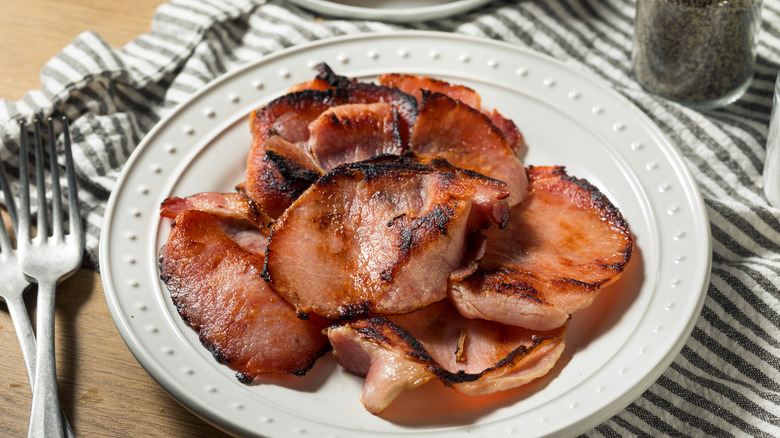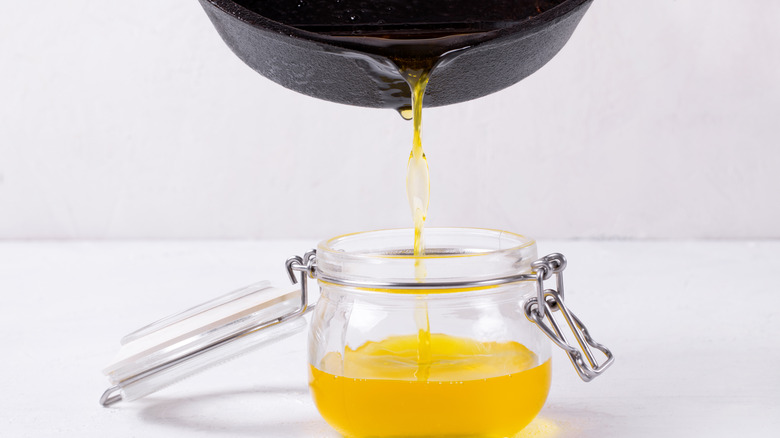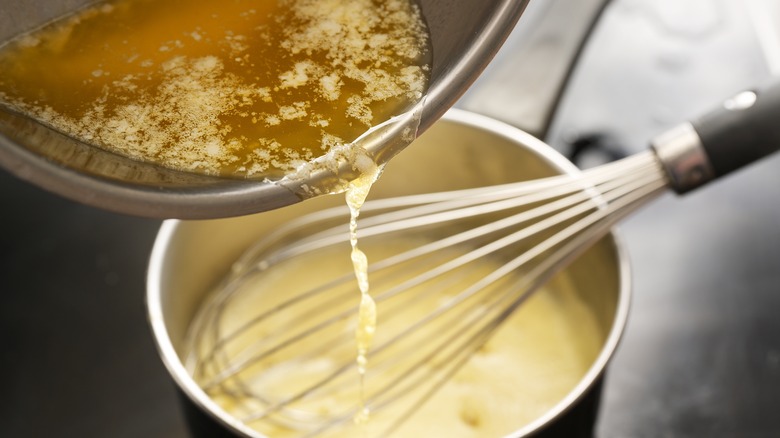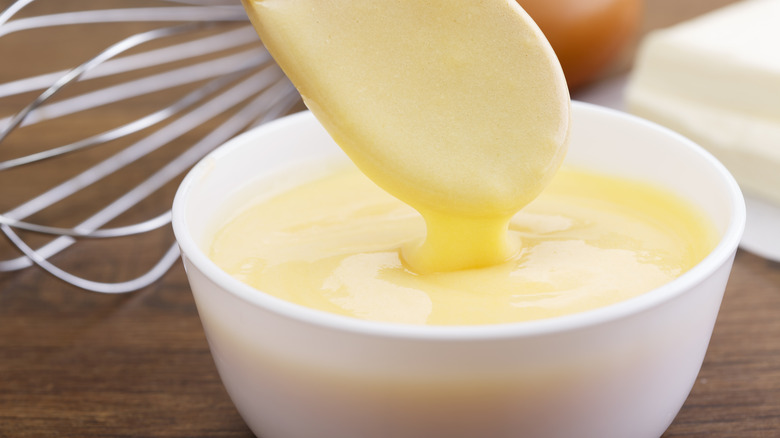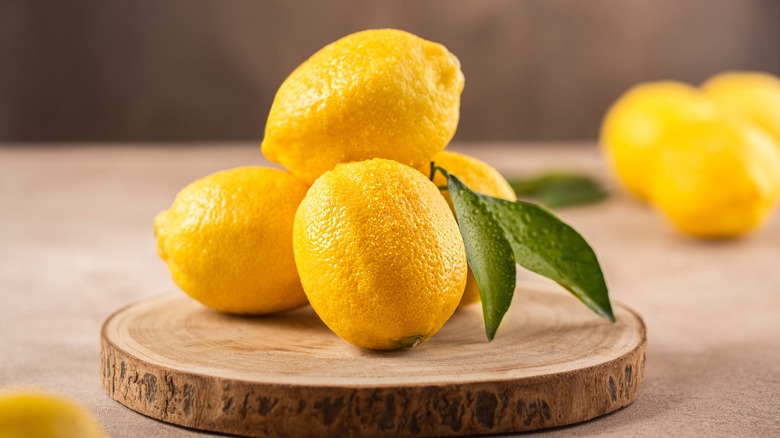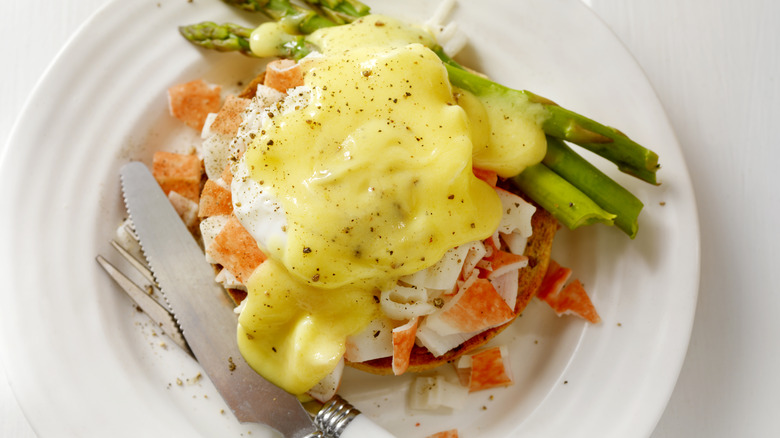15 Most Common Eggs Benedict Mistakes And How To Avoid Them
Eggs Benedict sounds terrifying to the uninitiated. To the initiated, you know there's a good reason for that: The persnicketyness of some of the ingredients, such as the poached eggs and hollandaise sauce, combine with the challenge of timing to create a perfect storm of potential disaster.
Yet the dish is so impressive, with a long history of eggs Benedict looking and tasting just plain awesome. Between making fluffy-as-clouds poached eggs and smooth-as-silk hollandaise, the amount of skill involved seems pretty jaw-dropping to others, especially as you can usually only get it in a restaurant. The best part? It's not nearly as hard as it seems once you learn to do it right. It's the "doing it right" that's the problem.
Never fear. While scaling the eggs Benny learning curve is tough, once you summit that peak, you will have a skill of which others are jealous ... or that simply makes them want to hit your house for Saturday brunch once a month. Without further ado, here are 15 mistakes to avoid on your journey to Benedict perfection.
1. Using weird egg-poaching tools
Poaching eggs is a delicate process, and while difficult to learn to do correctly, it becomes second nature after you do it a few times. Many people, however, feel scared to learn, which causes them to fall victim to the Weird Cooking Gadgets Industrial Complex and buy egg-poaching tools. These often look like flat metal pans or silicone molds with a bunch of little craters in them; you fill them with the eggs and then plunge straight into the simmering water. Others appear to be little baskets or, worst of all, throwaway poaching bags.
Don't buy them; these tools almost always make the process harder (and make your eggs look like space food), because they cook unevenly compared to putting your egg alone into the water. Plus, you have to put your hands closer to the simmering water than you do with the traditional method.
You should really just take the time to learn how to do it right. To accomplish this, check out this fool-proof poached egg recipe, then try it a few times. As you do, you'll work out the kinks, and the next few steps will help you avoid some of the most common poaching pitfalls.
2. Using too small a pot for poaching
Next up on our list of mistakes: using too small a pot to poach your eggs. Perfect poached eggs should only touch water while they're cooking. This keeps the white from hardening weirdly and ensures the egg is heated evenly from all sides. You don't want to cramp the egg. You also need enough room for the egg white to swirl onto itself, a necessity discussed in greater detail a few steps below.
By the same token, you don't want to use too little water either, because the egg won't get heated evenly. That can lead to a white that is only cooked partway, or yolks that get too hard on one side rather than retaining their delicious runniness.
Plus, eggs float inside the water and cannot rise up out of it, meaning they will flatten to the depth of the water you use. If you want that lovely round shape, you need to fill your pot to a depth of at least 4 inches.
3. Poaching more than two eggs at once
Again, eggs need room to spread out, which is why you don't want to use too small a pot. It's also why you need to avoid the temptation to poach a whole bunch of eggs at once. Sure, it's tempting to boil up a crab pot of water and then throw a whole dozen in, but this dramatically reduces the efficacy of the process and prevents you from fixing many of the mistakes below.
Instead, assume that two eggs is the max for poaching in a home kitchen, and that's assuming you're using a 4-quart saucepan. A 2½- to 3-quart pan will work for only one egg at a time. You can feel free to test this assertion, of course, and if you get good results, then more power to you. However, to get that fluffy white and runny yolk effect for which poached eggs are prized, one of the easiest things you can do is limit the size of each batch.
4. Forgetting to add vinegar to the poaching water
Vinegar has so many uses in the kitchen, from saving overly sticky rice to helping caramelize onions. If you're not using white vinegar to poach your eggs, what are you even doing? Okay, in all seriousness, this is an ingredient that's missing from some recipes, but you shouldn't skip it. Although you will find assertions that you don't need vinegar, it really helps when you're using older eggs that have less viscous whites because their albumin has started to break down. Serious eggs Benedict-ers swear by vinegar.
Why? Because to get egg white to cook and turn opaque, you need to denature it. Acid can help do this. "Vinegar is an inherently acidic material," explains Dr. Robert Keyzers of Victoria University of Wellington, Te Wānanga Matū's School of Chemical and Physical Sciences. "So if we add a few drops of vinegar into that boiling water, that is going to increase the rate of denaturing and it's going to make that happen faster and help the poached egg hold its shape better."
To use vinegar correctly, make sure not to add it until your water is at a low boil and ready for your egg. Then add a generous splash — around a tablespoon — to the water right before you drop your egg in.
5. Forgetting to swirl the water
Swirling your cooking water is another important tip. The outer white that surrounds an egg is loose and thin, especially when eggs are older and the albumin has broken down. If you use static cooking water, your egg immediately starts to fan out and cook when you put it in. This is the reason egg flower soup has those lovely frilly strands in it.
That's not optimal, which is why some cooks recommend straining your egg if you don't know when it came out of the chicken, because it reduces the watery outer layer. However, while this step can't hurt, it's an extra requirement that you might want to skip. Luckily, swirling your water can help improve the results of your egg no matter how old it is.
To encourage those strands to group together and become a nice, round shape, swirl your poaching water before dropping in your egg. Then watch the whirlpool do its job.
6. Cracking the egg right into your water
When you first go to poach an egg, the question becomes: How do you get it into the water? Many novice cooks grit their teeth and crack it straight on in, but that's a mistake. You simply can't get close enough to the surface of the water to put the egg in gently without scalding yourself, which forces you to bomb the water from 6 inches up, damaging the fragile egg and causing the white to shatter. Hello, egg flower soup.
Instead, use a mug or a ramekin. This allows you to gently crack the egg into the bowl, then slide it into the water with equal gentleness, all while keeping your fingers well out of first-degree-burn range. Place your egg in the exact center of the whirlpool for the most even results, where the motion of the water will immediately wrap the strands around into a globe shape.
7. Jiggling the egg when you take it out
Poached eggs are very tender, even more delicate than sunny-side-up or fried eggs. Treat them like newborn babies, moving them carefully and never shaking them. Otherwise, you run the risk of cracking open the soft white and releasing the golden yolk before you're ready. It's a last-minute eggs Benedict mistake anyone should avoid.
Of course, it's annoying to put a wet egg on top of your perfectly toasted English muffin and crisp Canadian bacon, so you should dry it off. To do so, use a slotted or clawed spoon to gently pull the egg from the water, then hold it above the pot to allow the moisture to run and steam off the egg for 20 seconds or so. Then add it to your muffin and top with sauce.
To further prevent a watery result, always put a layer of something between the English muffin and poached egg. Canadian bacon is the classic, but a layer of veggies or a thick slice of tomato can also do the trick. Your aim is simply to keep moisture from soaking your muffin and making it soggy.
8. Failing to cook your Canadian bacon enough
Canadian bacon is good, but it's a steeper climb to get it to crisp than regular sliced bacon because it has less fat. You need to leave it in the pan longer than you think, so make sure to get started on it after you finish the hollandaise and before you begin poaching.
The best way to cook Canadian bacon is on the stovetop, using a cast iron pan. Grease the pan lightly. Although Canadian bacon does not release vast quantities of lard à la strip bacon, it still puts off some fat, so you don't need much to start out. Note that this kind of meat doesn't get all bubbly-crisp, so instead look for caramelization across the flat surfaces. Once you're done cooking it, put it in a 250-degree Fahrenheit oven to keep warm until serving.
You can also use other types of meat for your Benedict. Traditional bacon is good, as are pancetta pieces or rounds. Eggs Benedict is also a great way to use up leftover holiday ham and makes a showstopping sendoff for out-of-town houseguests.
9. Forgetting to clarify butter before starting the sauce
Clarifying butter should get your full attention. It's easy to burn the butter while you're melting it on the stove, and it's equally easy to forget about it once melted and let it harden up while you're dealing with other ingredients. Boooooo.
Instead, clarify your butter before you start the Benedict-making process. Put it in a small metal pot and warm it over medium heat, stirring often. When fully melted, remove it from the heat and let it sit for a minute until the solids fall to the bottom. It should still be very hot when you pour it off. If there's foam on top, grab a spoon and skim it off first.
Then, grab a clear measuring cup and carefully pour the butter in until you see a bit of milk solids slide in. Stop immediately. Always do this before you start cooking the egg base for your sauce.
10. Cooking hollandaise on the bottom of the pot
Now it's time to make a nice lemony hollandaise sauce recipe. Before you begin, though, make this your religion: Never, ever, ever cook hollandaise without a double boiler. It will curdle or scramble every time, with no exceptions made for skill. (Okay, maybe Martha Stewart could do it, but you can't.) That's because egg yolks solidify very quickly with exposure to heat, and they are difficult to impossible to unscramble.
Instead, always use a double boiler. If you don't have one, place a glass mixing bowl above the water. This works just as well as a specialty setup. Make sure, though, that the bowl does not touch the water, which can also scald your eggs. Also make sure your water is simmering, not boiling, and already warm when you put your boiler on top of it.
Remember, when it comes to hollandaise sauce, heat is your friend but it is also your enemy. Once you put your egg yolks over heat, never stop whisking.
11. Abandoning a broken hollandaise
Hollandaise is a bit of a jerk. It is fussy, separates with no warning, and scrambles if you take your eyes off it for, like, two seconds. However, you can rescue a broken hollandaise using several tricks. Just make sure to distinguish between a broken and a scrambled sauce, which are two different things.
If your sauce has scrambled, you will see round, opaque bits in it. If that happens and you only see a few, you can probably save it. Quickly remove the sauce from the heat, cool it down by adding an extra pat of cold butter, and then pass it through a fine-mesh sieve. This will remove the parts of the yoke that cooked too quickly, leaving the rest of the sauce intact. You can then proceed as normal by adding the clarified butter, assuming your egg base is thick enough. If not, put it back on the heat and be more careful.
If your sauce has broken, you will see a distressing oil-and-water effect, as though parts of the sauce are floating in other, thinner parts of the sauce. Broken hollandaise may also look grainy, but still with that oily effect. If this happens, the first step is the same: Remove it from the heat and add an extra pat of cold butter to cool it down. Sometimes this is enough to bring the sauce back together, but if not, you can add an egg yolk to bind it anew.
12. Buying too few lemons
Lemon is absolutely critical to a tasty hollandaise sauce, and you'll find few recipes that don't call for it. While you can make a nice sauce without paprika or cayenne (though you shouldn't if you're going for the traditional vibe), skipping the lemon changes the sauce entirely. Don't do it.
The thing about lemons, though, is that you can't always count on them to be equally juicy. Nothing is more disappointing than cutting into one and getting a paltry squeeze, and there aren't any great substitutes for lemon juice. (Although in a pinch, a dry white wine or white wine vinegar will work.)
Instead of risking it, buy more lemons than the recipe says you need. Pro tip: Stop choosing lemons by color, shape, or other cosmetic features. Instead, pick up the lemons and weigh them in your hands. The heaviest ones are the best because they have the most juice. You can use this trick for any type of citrus!
13. Avoiding experimentation
Unless you are the Bobby Fischer of eggs Benedict, it's not going to come out that well the first time. This is a hard dish, which is the entire reason people are impressed when you make it for them. So instead of getting discouraged when it doesn't come out perfect the first time, keep at it.
You'll eventually learn tricks to make your hollandaise sauce go easier, such as keeping that extra egg yolk on hand and always buying more lemon than you need. Poached eggs will come easier over time as well, and don't be afraid to sift through old cookbooks or internet archives until you find a recipe that works for your stove, your climate, and your skill level.
You should not only experiment with the main ingredients but also with how to serve them. Try asparagus and dill hollandaise, smoked salmon rather than Canadian bacon, or tomatoes and basil. These are all lovely ways to update the classic recipe, and having them on hand makes it easier to serve vegetarians when they come over.
14. Trying to serve everyone at once
You're not a line cook, and that's okay. Poaching 12 eggs at the same time and/or trying to keep a bunch of poached eggs warm in a home kitchen is too tall a challenge, even for those who are experienced in making beautiful eggs Benedict.
For that reason, this writer likes to serve eggs Benny during a casual brunch with close family, where no one is expecting to do anything but lounge and chat anyway. That way, you can plate up one serving at a time while standing in a kitchen and enjoying the company of your fave peeps. Make sure to avoid an empty table, though. Put other dishes on the table ahead of time, such as fruit salad or pastries, and serve up some lovely noisette French-style coffee.
If you really want to seat everyone at once, you can make poached eggs in the oven using a muffin pan, no special tools needed. But beware, they'll look like something out of "The Jetsons."
15. Putting too much pressure on yourself
Look, eggs Benedict isn't an easy dish. But it is delicious, and no one should ban it from their home kitchen out of fear. Instead, take shortcuts if you need to. The main result will still be lovely and earn you applause from your adoring public.
If your sauce keeps breaking, you can buy store-bought hollandaise sauce, and it's pretty good. If you can't get poached eggs right but you want to serve everyone all at once, go ahead and fry or scramble your eggs instead. Your Benedicts will still taste good, and you can even poach scrambled eggs if you want that lovely soft bite that comes from a hot bath.
At the end of the day, good food is supposed to be fun. Fun to make and fun to eat. If you're stressed, you definitely won't have fun. Plus, your guests will feel guilty and sorry for you rather than spoiled and relaxed, so do whatever it takes to have a good time, even before you become an eggs Benedict expert.
